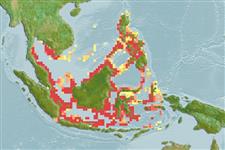>
Eupercaria/misc (Various families in series Eupercaria) >
Nemipteridae (Threadfin breams, Whiptail breams)
Etymology: Pentapodus: Greek, pente = five + Greek, pous = feet (Ref. 45335).
More on author: Bleeker.
Environment: milieu / climate zone / depth range / distribution range
Écologie
marin récifal; profondeur 2 - 20 m (Ref. 90102). Tropical; 20°N - 9°S, 92°E - 130°E (Ref. 3810)
Western Central Pacific: Philippines, Indonesia and Singapore. This species has been previously confused with Pentapodus trivittatus.
Taille / Poids / Âge
Maturity: Lm ? range ? - ? cm
Max length : 20.0 cm TL mâle / non sexé; (Ref. 90102); common length : 10.0 cm SL mâle / non sexé; (Ref. 3810)
Épines dorsales (Total) : 10; Rayons mous dorsaux (Total) : 9; Épines anales: 3; Rayons mous anaux: 7. Head scales reaching forward to between level of posterior and anterior nostrils. Suborbital naked. Lower limb of preopercle with 2 or 3 scale rows. Pelvic fins moderately long, reaching to or almost to level of anus. Axillary scale present. Color: Upper body brown, white on ventral surface. This species is easily distinguished from P. trivittatus by the head scales extending forward to the nostrils, the absence of scales on the suborbital, and presence of a white bar on the upper margin of the opercle.
Solitary or in groups in shallow silty coral reef areas (Ref. 90102). Feeds on small fishes, crustaceans (shrimps, caprellid amphipods) and polychaete worms.
Life cycle and mating behavior
Maturité | Reproduction | Frai | Œufs | Fécondité | Larves
Russell, B.C., 1990. FAO Species Catalogue. Vol. 12. Nemipterid fishes of the world. (Threadfin breams, whiptail breams, monocle breams, dwarf monocle breams, and coral breams). Family Nemipteridae. An annotated and illustrated catalogue of nemipterid species known to date. FAO Fish. Synop. 125(12):149p. Rome: FAO. (Ref. 3810)
Statut dans la liste rouge de l'IUCN (Ref. 130435: Version 2024-1)
Menace pour l'homme
Harmless
Utilisations par l'homme
Pêcheries: pêcheries vivrières
Outils
Can't connect to MySQL database fbquizv2. Errorcode: Too many connections
